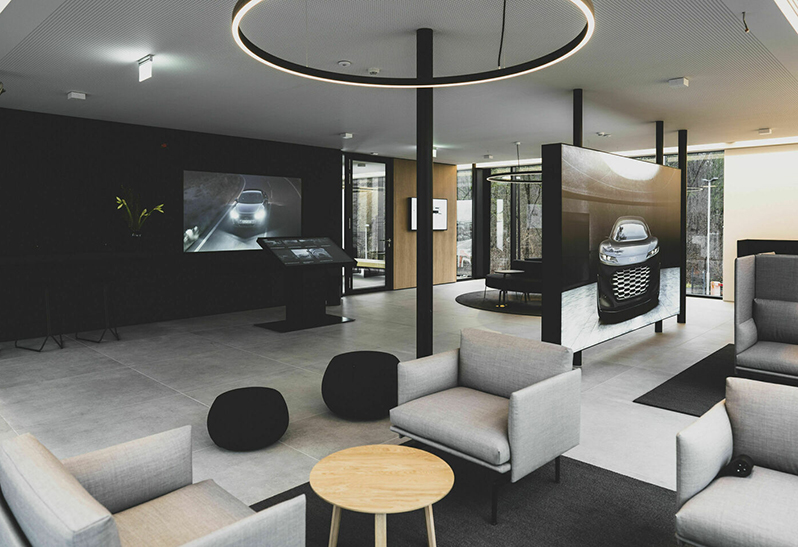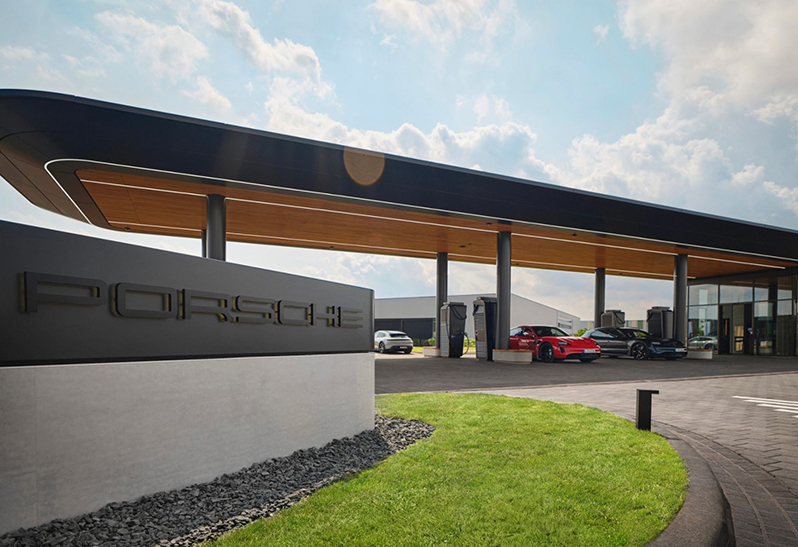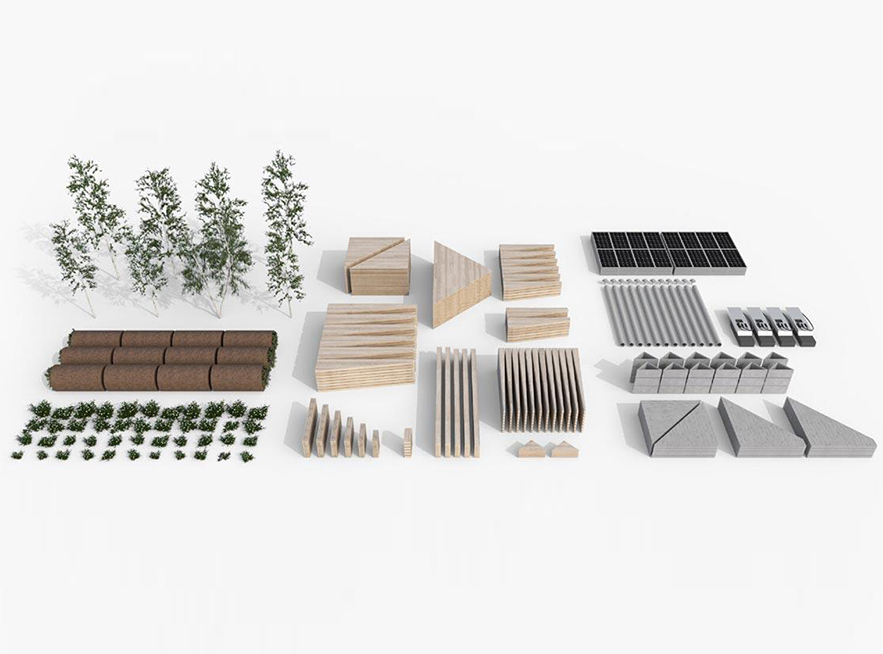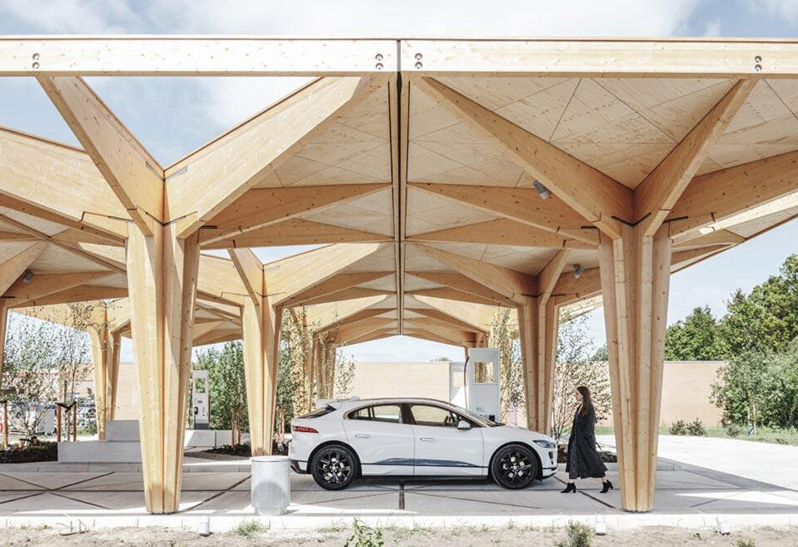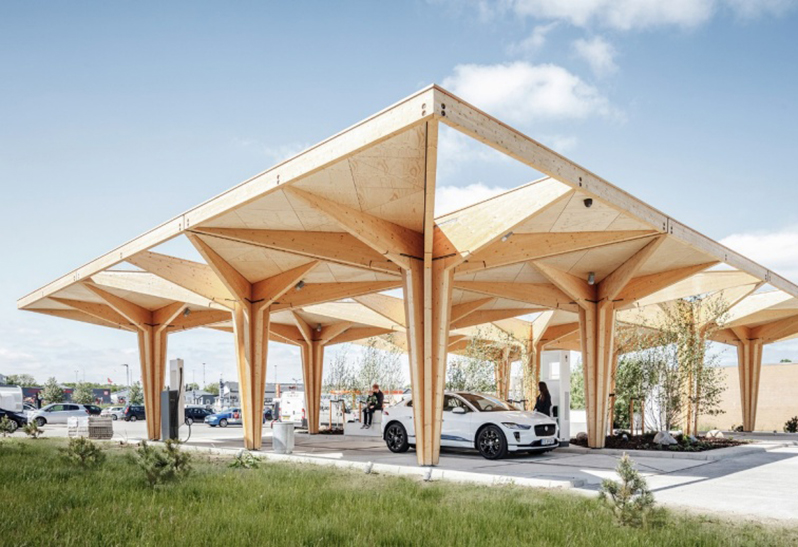Better Charging –
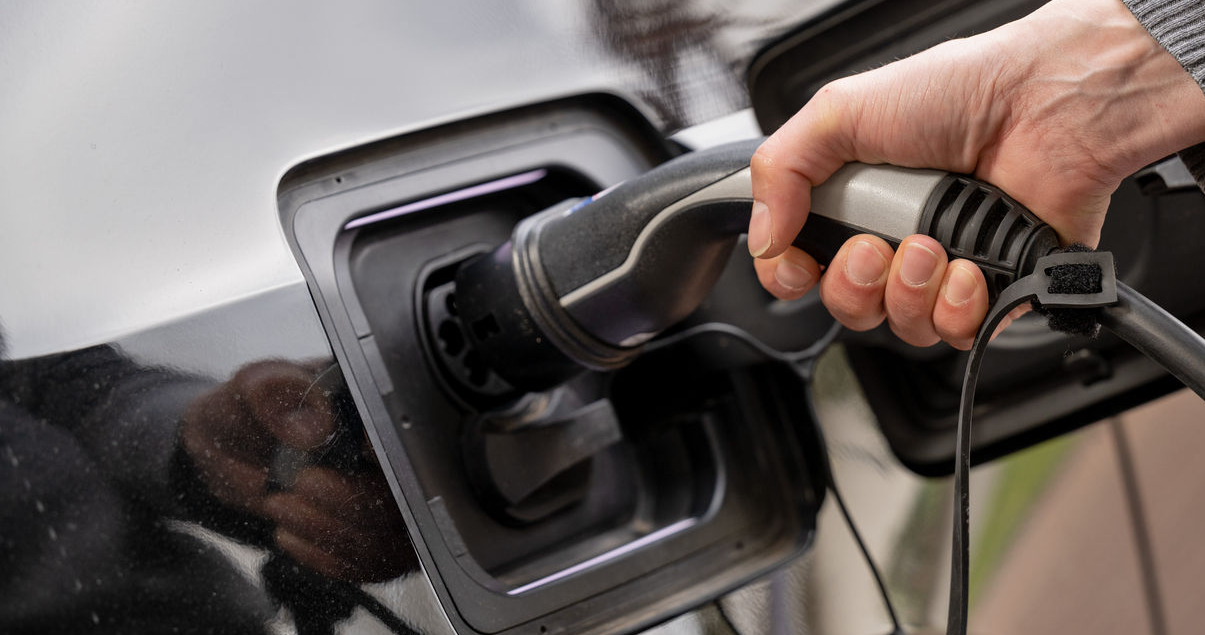
From swish solar roofs and elegant timber structures to coworking spaces, films and gym equipment, what will the filling station – or, more accurately, the charging station – of the future look like? At SMA Innovation Management, we’ve gazed into what lies ahead.
Ever since electric vehicles began to move beyond research facilities and the pages of lifestyle magazines and actually hit the roads, the practical matter of where to find the nearest charging station has become an issue relevant to the economy as a whole. The fate of the traditional filling station could soon shake up entire industries and shape markets. Where, how and when people will charge their electric cars in towns and cities, in the country and on the road is a matter for debate – and who will profit from it?
The idea that electric drive systems are going to replace the internal combustion engine the world over has been around for some time and offers plenty of room for speculation. Draft designs for future filling stations have won awards, and prototypes have been popping up everywhere. After years of attempts, Elon Musk has finally got the green light for his construction plans from the city of Los Angeles. His interpretation is a 1950s-themed diner complete with a cinema showing short films and parking spaces equipped with superchargers.
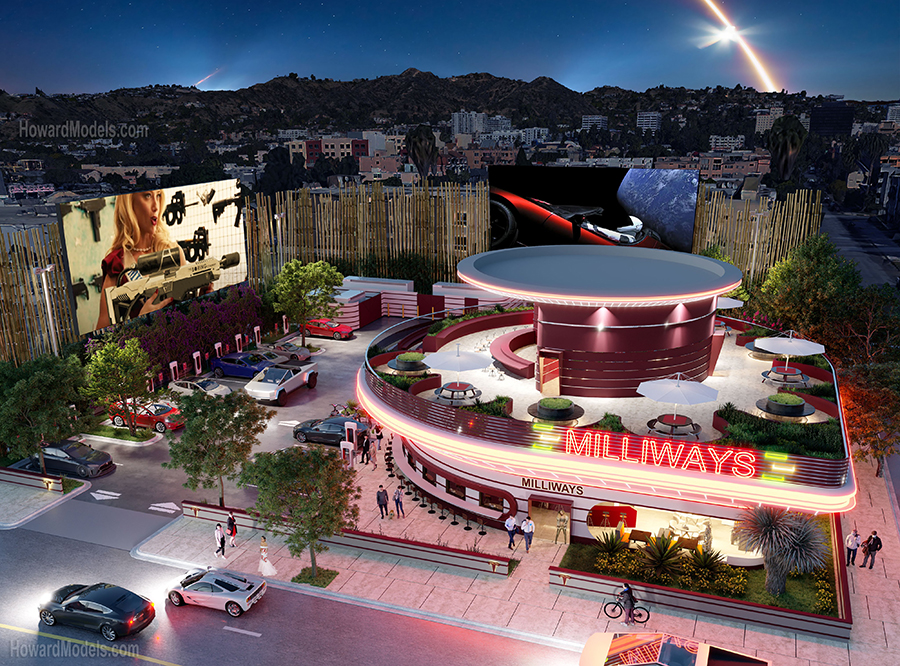 HowardModels
HowardModelsYet unlike voice assistants or booking platforms, electric vehicles do not constitute a sudden leap forward or a disruptive innovation. In fact, the transition from old to new is taking place at a rather sedate pace – far too slowly in some people’s opinions. “The world is going to remain powered by fossil fuels for now, maybe for another 10 years, maybe 20 – we don’t know. Either way, it’s going to be exciting when we reach the tipping point.” Carsten Gundlach is Senior Innovation Manager at SMA Solar Technology AG. His team monitors megatrends and microtrends over a period of three to ten years to identify areas in which the company needs to take action. Taking his cue from the 2022 Mobility Report from the Zukunftsinstitut [Future Institute], he outlines scenarios for the future of filling stations – and the filling stations of the future.
Electric vehicles are changing the “refueling” experience
“Fossil-fuel filling stations still dominate the landscape. How long that will remain the case, however, is difficult to judge,” said Gundlach. It is clear, he believes, that operators of filling stations will keep their businesses going as long as cars and especially trucks need to take on fuel. Some are making the minimal adjustment of installing a few fast chargers on their premises, perhaps along with services such as parcel counters.
At the same time, the refueling process is itself being modernized. Danish start-up Autofuel has installed a fully automated fueling system in Espoo in Finland. A robot opens the fuel filler flap, inserts the fuel nozzle and adds the requested amount of fuel. Chevron and Texaco offer apps that mean that you don’t have to go to the counter to pay. Instead, you can pay on your smartphone, and the app will even allow you to split the bill with your passengers if you so desire. Why are these things noteworthy? Because something that succeeds at conventional filling stations could influence future designs for charging stations.
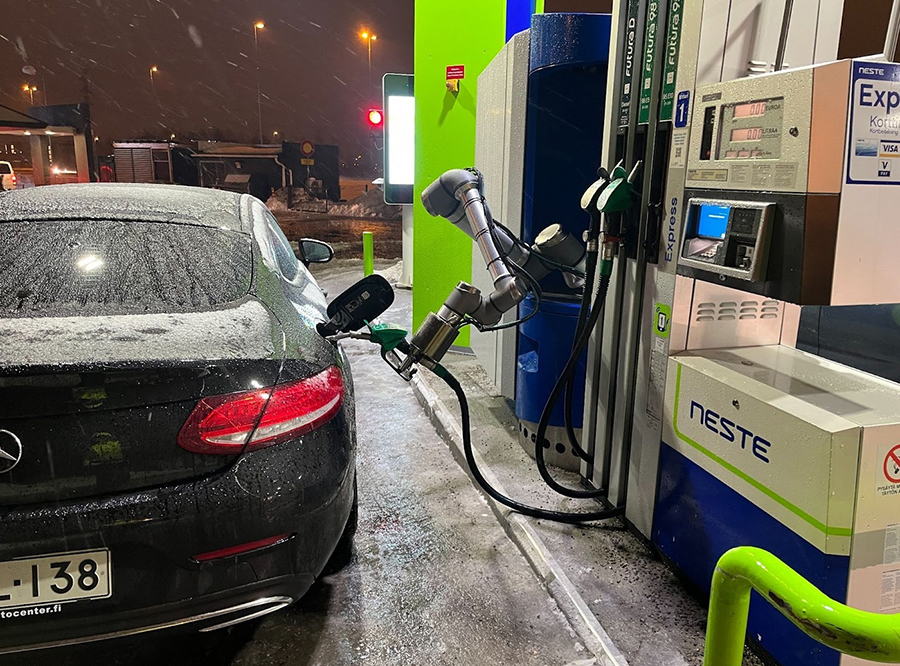 The Newsdesk
The NewsdeskA wholesale switch to electric vehicles will require a comprehensive charging infrastructure – and this is no simple undertaking. That being the case, it’s a good thing that oil companies with plenty of money are in need of new areas of business. Charging stations on the outskirts of towns and next to highways are essential for supplying commercial vehicles with electricity and hydrogen. Fortunately, the spaces currently occupied by filling stations are generally well suited to such applications. But that’s not all.
Most electric car users are dependent on public chargers, because not everyone has access to a parking space with a wallbox. That’s why in 2021, Shell acquired ubitricity, which helps cities expand their charging infrastructures. ubicitry made a name for itself by upgrading streetlights, making it easier to charge electric vehicles parked at the roadside.
Other scenarios put forward by the Zukunftsinstitut include the idea of using filling stations mercifully free of diesel fumes as meeting places for local communities or as transportation hubs combining all the things that make life easier for people using electric vehicles: car-sharing and intermodal transit offers, batteries to go, information and dining options for travelers.
What will the filling station of the future need – and what can be dispensed with?
Some of the trends forecast in 2022 have already become a reality, while others are only just starting to crystallize. The charging station of the future may end up being completely different. It could be adaptable, a brand experience or simply provide a practical service.
A full service for electric vehicles
British company GRIDSERVE has deliberately opted not to use the name “service station” for its charging stations, because it has its roots in the fossil fuel era. And its concept of “electric forecourts” appears to be bearing fruit. Three are already in operation, a further 11 are either being built or at the application stage, and the company is planning to expand into Scotland.
These electric forecourts are designed to do more than simply supply electricity to passing traffic. They feature large charging stations offering services for the local area – bookstores, post offices, cafés, grocery stores and workspaces that can be booked online.
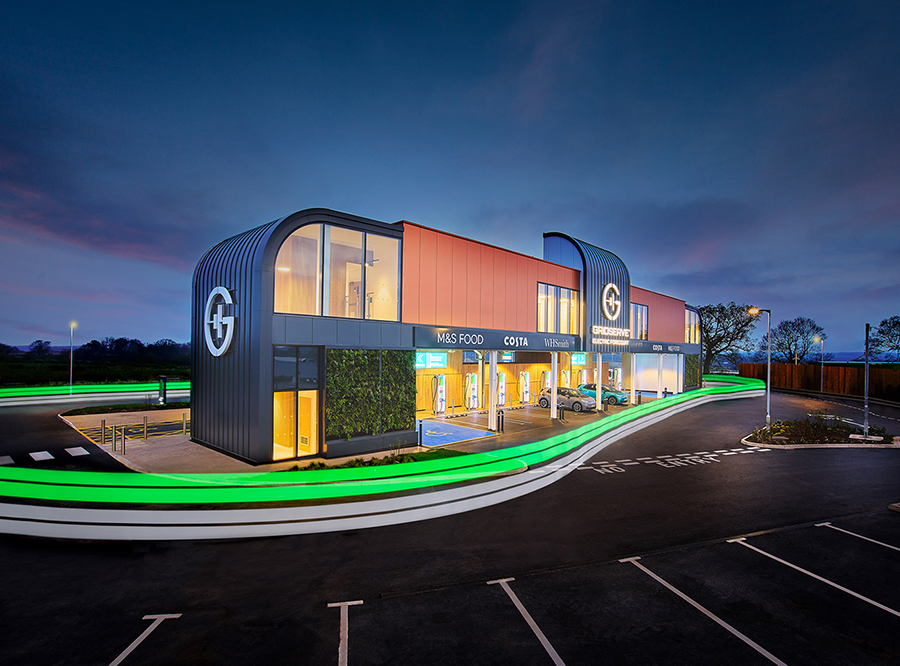 GRIDSERVE
GRIDSERVEThey are part of an overall strategy. Under its Sun-to-Wheel ecosystem, GRIDSERVE builds and operates charging networks for electric vehicles, generates the necessary solar power and offers electric vehicle leasing.
The Innovation Park in the Bavarian town of Zusmarshausen also has a higher purpose in mind. In addition to state-of-the-art charging points and places to rest, shop and park, a manufacturer of vehicle equipment named Sortimo has set up a campus there for digitalization, energy efficiency and innovation.
Showcasing the brand
“The idea of a charging station as brand experience is actually a new one. Filling stations have always traditionally represented oil companies,” said Gundlach. “Now, though, Audi and Porsche have opened exclusive charging lounges.” To access the Porsche Charging Lounge near Bingen am Rhein, drivers need to pre-register their license plates and then have them scanned on-site. In Nuremberg, the door is opened to Audi drivers either by a concierge or, outside business hours, when they enter a PIN. The services on offer range from meeting rooms and car valeting through to scooter rental and food delivery. Gundlach thinks this is also a great idea. “Second-life batteries from Audi test vehicles are used as buffer storage for direct current, which does away with the need for high-voltage connections and expensive transformers.” Tesla’s Milliways project is also a “brand experience,” with actual charging services taking second billing behind the site’s status as a “place to be.”
Proactively shaping change
“What I find exciting,” siad Gundlach, “is that a filling station is built to last forever. But we’re finding that charging services are appearing in places where people need them – in the parking lot of a shopping mall, for example. It starts with two charging points, or maybe four. If the transformer is designed to handle it and the demand is there, that number could be turned into eight or twelve in a few years’ time. Charging facilities are much more widespread, and everyone keeps moving.”
In other words, flexible and adaptable solutions have an advantage. British company 3ti promises that its Papilio3 pop-up solar charging station can be deployed and installed within 24 hours. Each of its charging stations consists of recycled shipping containers kitted out with 36 mounted solar modules supplying electricity, supported by a battery storage system. The rental price includes a smart charging and billing system.
The Hyper:Fuel Mobile Station, announced by Californian start-up Hyperion in late 2022, has a distinctly space-age look. These stations are designed to accommodate fuel-cell and battery-powered vehicles. At present, the company appears to be concentrating on vehicle development, but that does not mean that something similar won’t appear on the market soon.
Showing a little character
When broken down into its constituent parts, the charging station designed by Danish company COBE does not look like anything spectacular. Yet showcases by the multi-award-winning architectural firm give some idea of the leaps forward that could conceivably take place if the design reflects the character of the transition to electric vehicles. They show “an oasis far away from the noise and pollution of the traditional fossil-fuel-based gas stations,” with a design allowing the stations to be dismantled and reused as and when.
Mixing vision with pragmatism
Will elegantly designed charging stations made from renewable raw materials and offering “experiences” become the norm? Carsten Gundlach has his doubts. As far as he is concerned, solutions to practical everyday charging problems take priority. “Being able to get a coffee and go to the bathroom while your car is charging – that’s the minimum. It would be nice if I didn’t even have to get out of the car, if I could just let sensors and robots handle charging and payment. Like at the filling station in Finland, for example. One thing that’s absolutely essential is a canopy of some kind. After all, I need a moment to make sure that the charging process has started properly. I don’t want to be standing in the rain while I do that. At the same time, there need to be – and I think there will be – plenty of charging stations where I can spend a little time, maybe at a supermarket or a hardware store or something.” Finally, said Gundlach, the project needs to pay off. Time will tell what customers are willing to pay for.
Will fully automated battery swap stations and wireless on-road charging enjoy widespread acceptance? We’ll be asking SMA Innovation Management soon.


